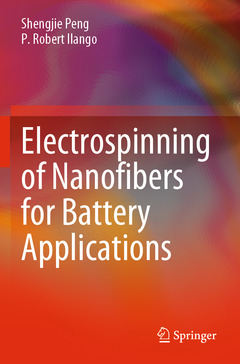Description
Electrospinning of Nanofibers for Battery Applications, 1st ed. 2020
Authors: Peng Shengjie, Ilango P. Robert
Language: English
Subject for Electrospinning of Nanofibers for Battery Applications:
105.49 €
In Print (Delivery period: 15 days).
Add to cart
Electrospinning of Nanofibers for Battery Applications
Publication date: 07-2021
158 p. · 15.5x23.5 cm · Paperback
Publication date: 07-2021
158 p. · 15.5x23.5 cm · Paperback
105.49 €
In Print (Delivery period: 15 days).
Add to cart
Electrospinning of Nanofibers for Battery Applications
Publication date: 07-2020
Support: Print on demand
Publication date: 07-2020
Support: Print on demand
Description
/li>Contents
/li>Biography
/li>Comment
/li>
This book comprehensively discusses the basic principles and working mechanism of all kind of batteries towards clean energy storage devices. In addition, it focuses on the synthesis of various electrode materials with 1D architecture via electrospinning technique. This book will give a clear idea about recent synthetic strategy towards nanofibers and nanocomposites for alkali-ion storage applications. The reader could understand the formation mechanism of nanofibers and their potential application in the future energy storage system.
Introduction.- Fabrication of Electrospun.- Electrochemical Energy Storage Devices.- Li-ion battery.- Na-ion battery.- K-ion battery.- Other alkali-ion batteries (Mg, Al, Ca).- Summary.
Prof. Shengjie Peng is currently a professor at the College of Materials Science and Technology, Nanjing University of Aeronautics and Astronautics, China. He received his Ph. D. degree in inorganic chemistry from Nankai University in 2010. His research interests focus on the development of rationally designed functional materials with finely tailored nanoscale architecture to tackle critical problems (such as energy density, power density, cycle and calendar life, safety, and cost) in diverse energy-related applications, including batteries, fuel cells, as well as clean and renewable energy.
Presents a detailed history of batteries and other energy storage devices Provides an outline of different dimension and structure of 0D, 1D, 2D and 3D materials Explains the working mechanism of electrospinning, enabling readers to find a synthesis of electrospun nanofibers through electrospinning technology Introduces the application of batteries in day-to-day life
© 2024 LAVOISIER S.A.S.

